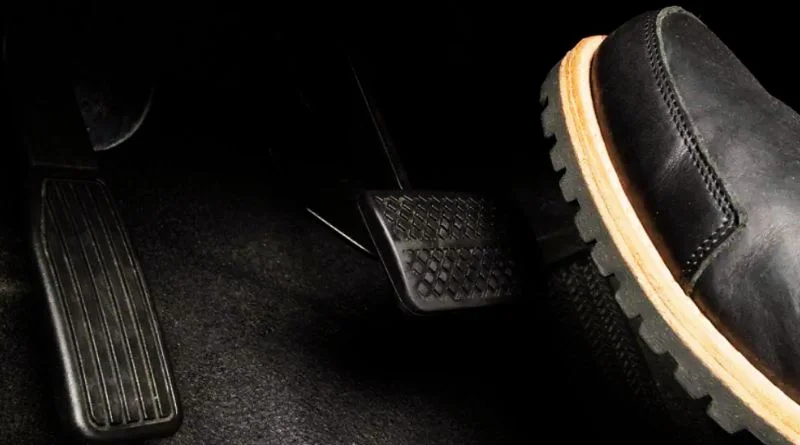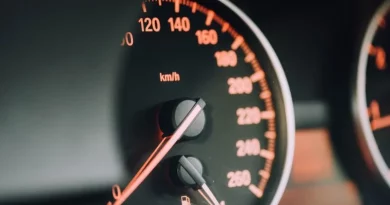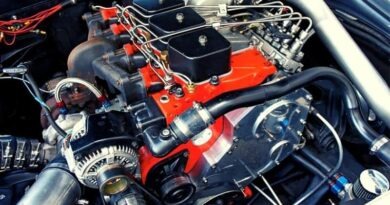Brake Pedal Goes To Floor After Changing Caliper – Causes & Solutions
Last updated on July 19th, 2024 at 09:26 am
The caliper helps slow down or stop your car by pressing the brake pads against the rotor. This happens every time you depress the brake pedal.
However, while the calipers can last between 75,000 and 100,000 miles, sometimes, they can wear earlier, requiring replacement. Depending on various factors, you may find the brake pedal going to the floor instead of being firm after the replacement of the caliper. Sometimes, this can happen despite bleeding the brake system.
So then, what does it mean when the brake pedal goes to the floor after changing the caliper? Read on to find out.
What Does It Mean When a Brake Pedal Goes to the Floor After Changing Caliper?
It can happen to the brake pedal going to the floor after installing new calipers. But what does it mean? Here is a list of all the things it might mean:
- Air is trapped in the brake lines
- The master cylinder is leaking, or it’s faulty
- The brake caliper was installed incorrectly
- The crush washers installed don’t match the new caliper
- Air in the ABS module
Without further ado, let’s find out how all the above causes the brake pedal to go to the floor after changing the caliper.
1. Air Trapped in the Brake Lines
One of the common causes of the brake pedal going to the floor after replacing the caliper is air in the lines. Generally, when you remove the caliper, this breaks the seal between it and the brake hose, allowing air in and brake fluid out.
As a result, the air in the brake system disrupts the hydraulic pressure in the lines, decreasing the brake pedal firmness. Unfortunately, sometimes air can still get trapped in the brake lines even after bleeding. This happens when you bleed the lines but don’t get all the air out.
Solution
The best solution here is to bleed the brake lines to get the air out of the brake lines. This will help restore brake fluid pressure in your vehicle’s braking system. Here is how to do it.
- Step 1: Jack up your car and remove all the wheels.
- Step 2: Find the bleeder screw situated on the back side of the calipers.
- Step 3: Use a wrench to loosen the bleeder screw on the brake caliper located at the farthest wheel from the master cylinder. It should be the right rear bleed screw, furthest from the driver.
- Step 4: Attach a plastic hose tightly to the bleeder screw and place the other end in a disposable bottle.
- Step 5: Have someone pump the brake pedal 4 to 5 times and then hold it down firmly.
- Step 6: Loosen the bleeder screw for one second or less to allow fluid to flow through the hose.
- Step 7: Tighten the bleed screw and ask your helper to release the brake pedal. Repeat steps 5 to 7 until there are no more air bubbles in the fluid.
- Step 8: Repeat the bleeding process on the other 3 remaining wheels, beginning with the left rear, right front, and left front if you also changed them. Be sure to add more fluid to ensure brake fluid does not go below the minimum line.
Alternatively, you could bleed the brakes using a brake bleeding vacuum pump (Our Pick). The pump comes with accessories like a reservoir, hoses, and bleeder screw fittings. Here are step-by-step instructions on how to use the pump. You can also watch this video:
- Step 1: Lift your car using a floor jack, remove the wheels, and locate the bleeder screw.
- Step 2: Loosen the bleeder screw using a wrench or socket.
- Step 3: Get your vacuum pump. Then, attach the pump’s rubber hose to the bleeder screw on the rear passenger side wheel.
- Step 4: Pump the vacuum between 20 and 30 inches of mercury (hg) to clear out the negative pressure at the bleeder screw.
- Step 5: Loosen the bleeder screw about a quarter of a turn and pump the vacuum to flush out the fluid.
- Step 6: When done, tighten the bleeder screw. Then, move on to the other wheels and repeat the bleeding. Always check the fluid level and add more as needed.
2. Leaking or Faulty Master Cylinder
Sometimes, an internal or external leak to the master cylinder may cause the brake pedal to go to the floor after changing the caliper. An internal leak can happen when you pump the brake pedal too hard during bleeding.
A leak in the master cylinder can also occur due to worn-out seals. As it turns out, the master cylinder has two plastic cup seals to keep brake pressure and fluid contained. Generally, a leak causes a low fluid level in the master cylinder reservoir, leading to the brake pedal going to the floor.
Solution
The best way to fix a leaking or faulty master cylinder is to replace the damaged seals or the entire cylinder. To replace the seals and master cylinder, follow the steps below.
- Step 1: Lift up the vehicle and remove the tires. Then, loosen the master cylinder reservoir cap screw and drain the fluid.
- Step 2: Disconnect all the brake lines using a wrench from the master cylinder.
- Step 3: Unscrew the bolts attaching the master cylinder to the brake booster and remove the cylinder.
- Step 4: Remove the damaged seals, piston, and spring from the master cylinder using a flat-blade screwdriver.
- Step 5: Use a brake cleaner to clean the inside of the master cylinder and blow it with compressed air.
- Step 6: Apply grease on the new seals, piston, and spring. Then, install them.
- Step 7: If the master cylinder is also faulty, replace it rather than just the seals.
- Step 8: Bench bleed the master cylinder. You simply press the plunger for 10 to 15 seconds at a time. Then, stop once the plunger cannot be pressed in more than at least 1/8-inch.
- Step 9: Reattach the brake lines to the master cylinder. Then, bleed the brake lines manually or using a vacuum pump and top up the brake fluid.
3. Incorrect Caliper Installation
Sometimes, you may switch the right and left calipers, installing each on the wrong side. In this case, you will notice the bleeder screws are upside down or at the bottom of the calipers instead of at the top.
When this happens, air is usually trapped at the top of the caliper. This causes the brake fluid to exit the caliper from the bottom, preventing the trapped air from escaping.
Therefore, even if you bleed the brakes, you won’t get any air bubbles out of the brake lines. As a result, the brake pedal would go to the floor.
Solution
You need to uninstall the calipers and reinstall them back correctly. Then, bleed all the brakes manually.
4. Wrong Crush Washers
Most caliper kits come with various accessories, including crush washers. Therefore, when changing the calipers, you also have to replace the washers. These washers help create a tight seal, preventing leaks in the brake lines.
However, some kits don’t include new washers. In this case, most people usually use the old crush washers. Sadly, sometimes, the old washers may not be a perfect match for the new calipers. This is because not all washers are a universal fit as they differ in size.
Here is what the crush washers look like:

Solution
Get the correct crush washers (Our Pick) that match your new calipers and install them. To install the washers, follow the step below:
- Step 1: Lift your car off the ground using jack stands.
- Step 2: Find the brake caliper near the wheel assembly.
- Step 3: Unfasten the caliper bolts using a wrench and remove the caliper.
- Step 4: Disconnect the brake line from the caliper and drain the brake fluid.
- Step 5: Locate the crush washers along the brake line where it attaches to the caliper.
- Step 6: Remove the wrong washers and install the correct ones.
- Step 7: Reinstall the calipers, brake lines, and caliper bolts.
- Step 8: Bleed the brakes to remove any air bubbles.
- Step 9: Lower your car and test the brakes.
5. Air in the ABS Module
The ABS or Anti Lock Brake System helps prevent the wheels from locking up while braking aggressively. Unfortunately, if you let the master cylinder drain out completely while changing the caliper, air may get trapped in the ABS system. In this case, you can get initial pressure on the brake pedal before the pedal goes to the floor.
Solution
Like with the brake lines, the solution is to bleed or cycle the ABS module to remove the trapped air. The easiest way to bleed the module is using an OBD2 scanner. Here is how to do it:
- Step 1: Connect the scanner to the OBD-II port on your car. You can find the port underneath the dashboard on the driver’s side.
- Step 2: Turn on your OBD2 scanner and go to the main menu. Then, select maintenance and service. Next, choose bleed ABS.
- Step 3: After that, choose your vehicle’s make and select the area of the brakes you want to bleed. The instructions on how to do the bleeding will appear on the scanner.
- Step 4: Raise your vehicle off the ground and remove all the wheels.
- Step 5: Locate the bleeder valve and remove the cap. Then, attach a small tube or hose to the bleeder valve and the other end into a container.
- Step 6: Refill the brake fluid and have someone push the brake pedal inside.
- Step 7: Next, activate the scanner tool by pressing OK while the foot is still on the brake pedal. This will allow bleeding to run for at least 4 seconds. Then, open the bleeder valve.
- Step 8: After 4 seconds, close the bleeder valve and let your helper remove their foot from the brake pedal.
- Step 9: On the scanner tool, press ‘yes’ to repeat the process or ‘exit’ to end the bleeding.
Below is a video of how to bleed the brakes using an OBD2 scanner tool:
Final Thoughts
The brake pedal is notorious for sinking to the floor after changing the caliper for several reasons. However, depending on the cause of the problem, proper diagnosis is critical.
Once you have determined the cause, you must fix the problem immediately to avoid further damage to other brake system components.
The good news? It is easy to fix a brake pedal that sinks to the floor. Therefore, you don’t need to hire a professional mechanic to fix the brake pedal problem for you. The important thing is knowing how to bleed the brake system and ABS module correctly.


![How to Change a Tire of a Lowered Car [10 Easy Steps]](https://www.mydrivecar.com/wp-content/uploads/2023/02/How-to-Change-a-Tire-of-a-Lowered-Car-390x205.webp)

